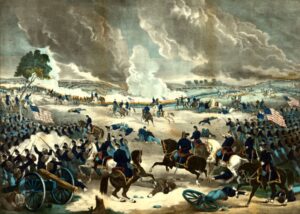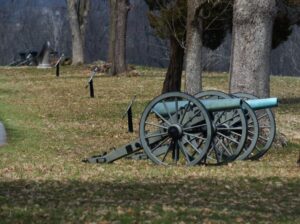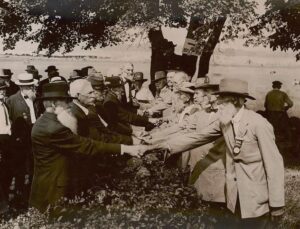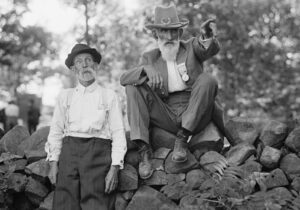
 War is a really horrific thing for soldiers to go through, and closure comes in different forms for different soldiers. Returning to the battlefield is a way to find closure for many veterans. It is also a way for solders to keep the friendships they made at a time when their life depended on their fellow soldiers. Countless numbers of men have returned to places like the beaches of Normandy, France to see that place again, where so many lost their lives. Some soldiers didn’t leave the place they fought in their war. Vietnam was that way to a degree.
War is a really horrific thing for soldiers to go through, and closure comes in different forms for different soldiers. Returning to the battlefield is a way to find closure for many veterans. It is also a way for solders to keep the friendships they made at a time when their life depended on their fellow soldiers. Countless numbers of men have returned to places like the beaches of Normandy, France to see that place again, where so many lost their lives. Some soldiers didn’t leave the place they fought in their war. Vietnam was that way to a degree.
The Civil War was unique in that when the veterans decided to have their reunion, they wanted to, of course renew old friendships with those they shared a common bond, but they also wanted to make their reunion a way to bring the north and south back together again. The Gettysburg, Pennsylvania reunion was the largest of these events, and so made headline news around the world. The event took place in 1913 at Gettysburg, Pennsylvania. The Civil War was unique in that all participants were citizens of the United States. Brother fought against brother, and family members against family members. The reunion was a chance to repair those horribly broken relationships for all the men who were still alive at the reunion, which was held on the 50th anniversary of the battle. General H.S. Huidekoper, a Gettysburg Veteran of the 150th PA., was the man behind the idea of making it a gathering of both Northern and Southern Veterans on the 50th Anniversary of the battle. With the state of Pennsylvania, acting as host, $400,000 was set aside to finance the event. The Federal Government added $195,000 and the volunteer services of 1,500 officers and enlisted men. The event was five years in the planning, with Veteran groups throughout the nation helping to make it happen.
The Veterans who were still alive were aging, and because of the reunion, they were able not only to renew the friendships they had, but new friendships were born, and old wounds healed as well. The youngest Veteran, Colonel John C. Clem (known as the Shiloh drummer boy), was 62 years old. The oldest Veteran was 112 years of age. A total of 55,000 veterans attended the event, representing the half million living Confederate and Union Veterans. Of the 55,000 men, 22,103 came from Pennsylvania, and of those, 303 were Confederate. The smallest delegation came from New Mexico…one, a Union Veteran.
The event…one I wish I could have seen, saw over 5,000 tents, covering 280 acres in the middle of the battlefield, where so many had lost their lives. It was almost as if they were there too…giving their approval. Distinguished guests had come to give speeches and presentations. General Daniel Sickles, representing the III Corps at Gettysburg where he lost his leg, was the only corps commander present. On behalf of the battle leaders were the daughter of General Meade and the grandchildren of Generals Longstreet, A.P. Hill and Pickett.
The reunion lasted a full week. The men ate well and swapped stories, cried and laughed. In all 688,000 meals were served by two thousand cooks and helpers. Amazingly and considering the age and health of the Veterans, along with the hot, sultry weather, there were only nine Veterans who did not survive the week, a number well below the normal mortality rate for that day. Perhaps it was the exhilaration of the joining of old friends, reliving days of their youth, hearing the infamous Rebel Yell resound across the battlefield, or reenacting Pickett’s charge to have the Stars and Bars meet the trefoil of Hancock’s II Corps once more that had lengthened their lives.
In the most stunning moment of the event…on the fourth of July at high noon, a great silence fell over the battlefield, as the church bells began to toll. Buglers of the blue and gray prepared to play the mournful tune of Taps one last time. The guns of Gettysburg shook the ground, signaling the end of the weeklong event. When I visited Gettysburg many years later, I was surprised by exactly how that place felt. You could feel the atmosphere there all those years later. It is hallowed ground. You feel like you should whisper…or better yet just be silent. I have never felt that way before, or since.
And though many eloquent speeches were given at Gettysburg that week, none expressed what these Veterans took away from this experience better than a scene witnessed at the train station: “Nearly all of the men had said their good-byes and headed for home. On the station platform a former Union soldier from Oregon and a Louisiana Confederate were taking leave of each other. They shook hands and embraced, but neither seemed 
 able to find the words to express his feelings. Then an idea seemed to strike both men at once. In a simple act, which seemed to say everything they felt the pair took off their uniforms and exchanged them. The Yankee went home in Rebel gray, the Confederate in Union blue.” The above quote is an excerpt from “Gettysburg: The 50th Anniversary Encampment,” by Abbott M. Gibney, Civil War Times Illustrated, October 1970.
able to find the words to express his feelings. Then an idea seemed to strike both men at once. In a simple act, which seemed to say everything they felt the pair took off their uniforms and exchanged them. The Yankee went home in Rebel gray, the Confederate in Union blue.” The above quote is an excerpt from “Gettysburg: The 50th Anniversary Encampment,” by Abbott M. Gibney, Civil War Times Illustrated, October 1970.


One Response to Return To Gettysburg